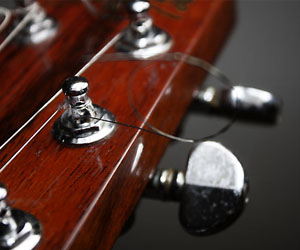Tuning Pegs Guitar
When playing guitar, tuning is a crucial aspect of preparation. The use of machineheads, aka: tuning pegs or guitar "heads" allow instrumentalists to tune strings up or down harmonically. Without tuning pegs, guitar playing would be entirely more difficult: some passages are specifically written in dropped tuning, for instance. If the tuning pegs on your guitar have been lost or damaged, your guitar is effectively useless. Luckily, these are among the most common parts to find for guitar when looking online.
Machineheads for Your Guitar
There are a plethora of places available online that have a variety of tuning pegs. Guitar enthusiasts and first time players can get a lot of out any of these sites as there are detailed product descriptions with each part: that way you can be sure that you're getting what you need! Some places to check include:
- J &R Music and Computer Workshop
- Buy.com
- Musician's Friend
- Sam Ash
You'll be able to find varied assortment between brands and manufacturers of tuning pegs. Guitar manufacturers sometimes even make guitars with specifically complex tuning pegs such as the inline six. These will cost more than average but they only fit certain, expensive models of guitars.
Why Upgrading Tuning Pegs is Necessary
Tuning pegs are the reliability in your tone: if you don't have solid tuning pegs that effectively lock your string in place throughout your daily schedule of playing, your tuning will be off within hours of playing. This requires constant retuning and becomes a nuisance, especially because there's an effective fix: new tuning pegs! Tuning pegs also vary by size. Larger tuning pegs are easier to yield larger increments in pitch change with each revolution. These styles of tuning pegs tend to look more classical. Similar trim is used in tuning pegs of orchestral basses and string instruments. If you need to lock into the right pitch quickly before a performance and know that despite laying into your strings, the pitch you tuned to will remain true, upgrading your tuning pegs is the only way. Difficult passages in written pieces may not facilitate on the spot tunings and whenever you stop playing to tune, your band will most certainly be lacking without you.
You can tell if you need new machineheads simply by ascertaining if it's difficult to tune up or down in pitch and whether your instrument tends to go flat after short amounts of playing. If these two symptoms are present, you definitely should invest in new heads.
Getting More Out of Your Tuning
When the band tunes, it's so that all instruments harmonize properly and that there's no subtle clashes in sound. If you have an instrument that you tune before practice and performances that loses its pitch after a mere thirty minutes of playing, what do you think is wrong? It's your heads. These are the pieces attached to the headstock that you turn to tighten or loosen your strings to get them in tune. Better machineheads basically mean longer lasting tunings.

